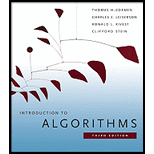
Introduction to Algorithms
3rd Edition
ISBN: 9780262033848
Author: Thomas H. Cormen, Ronald L. Rivest, Charles E. Leiserson, Clifford Stein
Publisher: MIT Press
expand_more
expand_more
format_list_bulleted
Question
Chapter 16.2, Problem 7E
Program Plan Intro
To give an
Expert Solution & Answer
Want to see the full answer?
Check out a sample textbook solution
Students have asked these similar questions
What IETF protocol is NetFlow associated with?
Group of answer choices
IPX/SPX
IPIX
HTTPS
SSH
How can I perform Laplace Transformation when using integration based on this?
Write an example of a personal reflection of your course.
- What you liked about the course.
- What you didn’t like about the course.
- Suggestions for improvement.
Course: Information and Decision Sciences (IDS)
The Reflection Paper should be 1 or 2 pages in length.
Chapter 16 Solutions
Introduction to Algorithms
Ch. 16.1 - Prob. 1ECh. 16.1 - Prob. 2ECh. 16.1 - Prob. 3ECh. 16.1 - Prob. 4ECh. 16.1 - Prob. 5ECh. 16.2 - Prob. 1ECh. 16.2 - Prob. 2ECh. 16.2 - Prob. 3ECh. 16.2 - Prob. 4ECh. 16.2 - Prob. 5E
Ch. 16.2 - Prob. 6ECh. 16.2 - Prob. 7ECh. 16.3 - Prob. 1ECh. 16.3 - Prob. 2ECh. 16.3 - Prob. 3ECh. 16.3 - Prob. 4ECh. 16.3 - Prob. 5ECh. 16.3 - Prob. 6ECh. 16.3 - Prob. 7ECh. 16.3 - Prob. 8ECh. 16.3 - Prob. 9ECh. 16.4 - Prob. 1ECh. 16.4 - Prob. 2ECh. 16.4 - Prob. 3ECh. 16.4 - Prob. 4ECh. 16.4 - Prob. 5ECh. 16.5 - Prob. 1ECh. 16.5 - Prob. 2ECh. 16 - Prob. 1PCh. 16 - Prob. 2PCh. 16 - Prob. 3PCh. 16 - Prob. 4PCh. 16 - Prob. 5P
Knowledge Booster
Learn more about
Need a deep-dive on the concept behind this application? Look no further. Learn more about this topic, computer-science and related others by exploring similar questions and additional content below.Similar questions
- using r languagearrow_forwardI need help in explaining how I can demonstrate how the Laplace & Inverse transformations behaves in MATLAB transformation (ex: LIke in graph or something else)arrow_forwardYou have made the Web solution with Node.js. please let me know what problems and benefits I would experience while making the Web solution here, as compared to any other Web solution you have developed in the past. what problems and benefits/things to keep in mind as someone just learningarrow_forward
- PHP is the server-side scripting language. MySQL is used with PHP to store all the data. EXPLAIN in details how to install and run the PHP/MySQL on your computer. List the issues and challenges I may encounter while making this set-up? why I asked: I currently have issues logging into http://localhost/phpmyadmin/ and I tried using the command prompt in administrator to reset the password but I got the error LOCALHOST PORT not found.arrow_forwardHTML defines content, CSS defines layout, and JavaScript adds logic to the website on the client side. EXPLAIN IN DETAIL USING an example.arrow_forwardusing r languangearrow_forward
arrow_back_ios
SEE MORE QUESTIONS
arrow_forward_ios
Recommended textbooks for you
 Operations Research : Applications and AlgorithmsComputer ScienceISBN:9780534380588Author:Wayne L. WinstonPublisher:Brooks Cole
Operations Research : Applications and AlgorithmsComputer ScienceISBN:9780534380588Author:Wayne L. WinstonPublisher:Brooks Cole C++ Programming: From Problem Analysis to Program...Computer ScienceISBN:9781337102087Author:D. S. MalikPublisher:Cengage LearningProgramming Logic & Design ComprehensiveComputer ScienceISBN:9781337669405Author:FARRELLPublisher:Cengage
C++ Programming: From Problem Analysis to Program...Computer ScienceISBN:9781337102087Author:D. S. MalikPublisher:Cengage LearningProgramming Logic & Design ComprehensiveComputer ScienceISBN:9781337669405Author:FARRELLPublisher:Cengage C++ for Engineers and ScientistsComputer ScienceISBN:9781133187844Author:Bronson, Gary J.Publisher:Course Technology Ptr
C++ for Engineers and ScientistsComputer ScienceISBN:9781133187844Author:Bronson, Gary J.Publisher:Course Technology Ptr EBK JAVA PROGRAMMINGComputer ScienceISBN:9781337671385Author:FARRELLPublisher:CENGAGE LEARNING - CONSIGNMENT
EBK JAVA PROGRAMMINGComputer ScienceISBN:9781337671385Author:FARRELLPublisher:CENGAGE LEARNING - CONSIGNMENT LINUX+ AND LPIC-1 GDE.TO LINUX CERTIF.Computer ScienceISBN:9781337569798Author:ECKERTPublisher:CENGAGE L
LINUX+ AND LPIC-1 GDE.TO LINUX CERTIF.Computer ScienceISBN:9781337569798Author:ECKERTPublisher:CENGAGE L

Operations Research : Applications and Algorithms
Computer Science
ISBN:9780534380588
Author:Wayne L. Winston
Publisher:Brooks Cole

C++ Programming: From Problem Analysis to Program...
Computer Science
ISBN:9781337102087
Author:D. S. Malik
Publisher:Cengage Learning

Programming Logic & Design Comprehensive
Computer Science
ISBN:9781337669405
Author:FARRELL
Publisher:Cengage

C++ for Engineers and Scientists
Computer Science
ISBN:9781133187844
Author:Bronson, Gary J.
Publisher:Course Technology Ptr

EBK JAVA PROGRAMMING
Computer Science
ISBN:9781337671385
Author:FARRELL
Publisher:CENGAGE LEARNING - CONSIGNMENT

LINUX+ AND LPIC-1 GDE.TO LINUX CERTIF.
Computer Science
ISBN:9781337569798
Author:ECKERT
Publisher:CENGAGE L
Dynamic Programming - Learn to Solve Algorithmic Problems & Coding Challenges; Author: FreecodeCamp.org;https://www.youtube.com/watch?v=oBt53YbR9Kk;License: Standard YouTube License, CC-BY